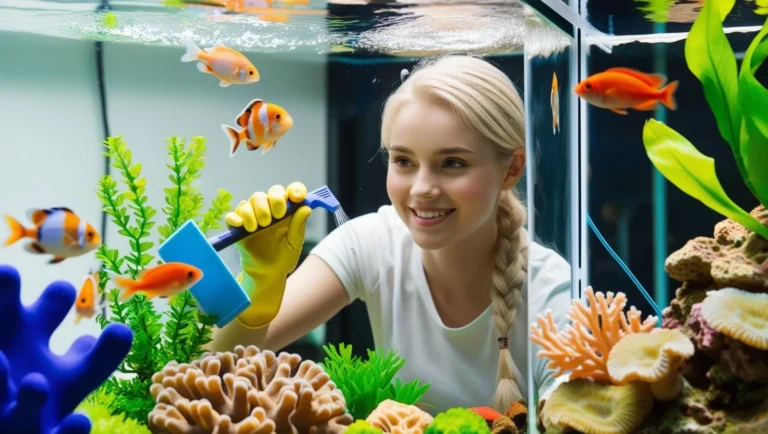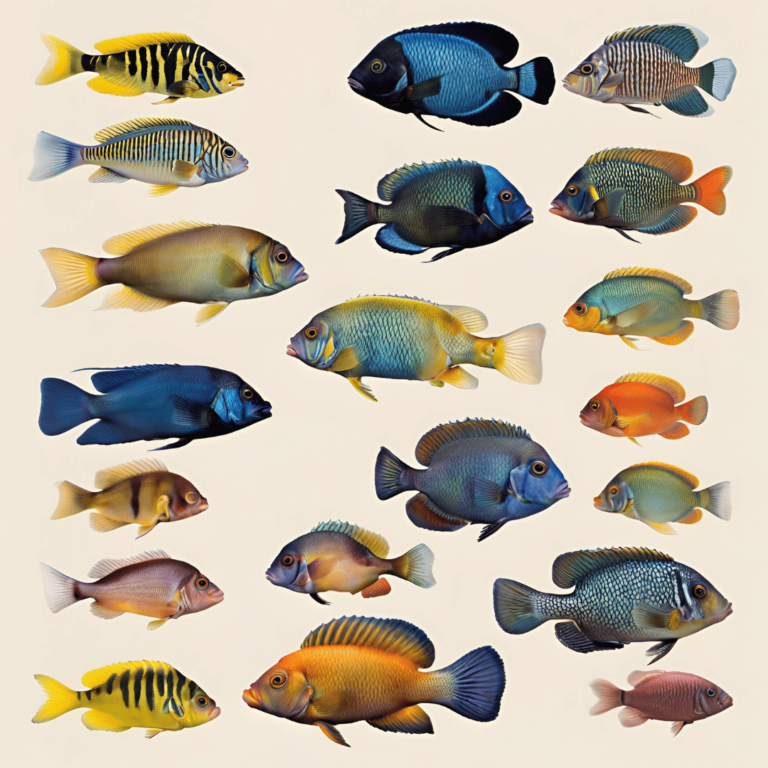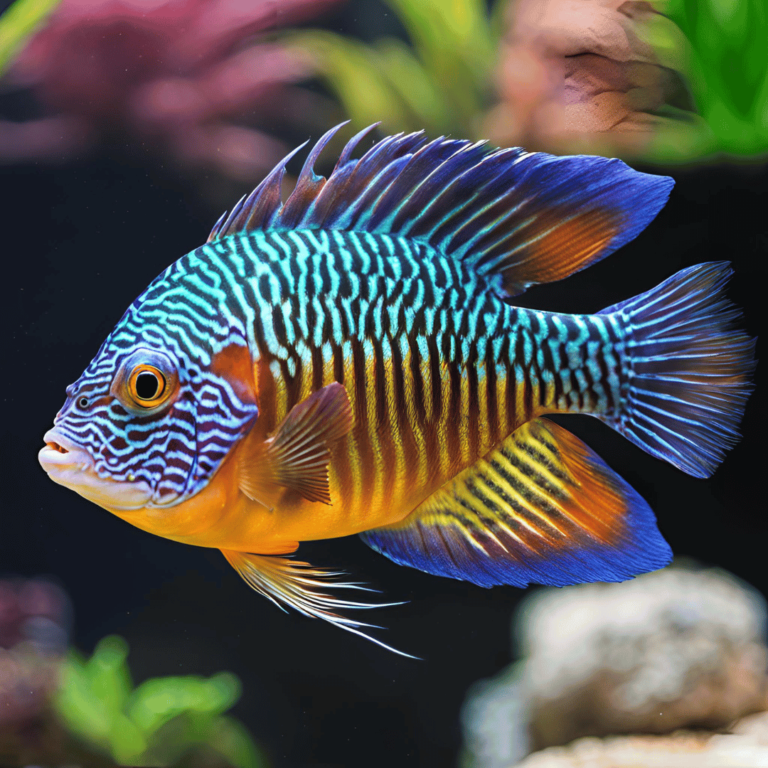Your trusted guide to cichlid care, tank setups, and quality products.

Peacock Cichlid Tank Maintenance: 14 Proven Tips for Success
Maintain a healthy and vibrant peacock cichlid tank with our comprehensive maintenance routine! Learn the essential tasks, recommended frequency, and tips for keeping your water quality pristine and your fish thriving year-round.
Image credit Canva
Peacock cichlids are vibrant, fascinating fish that require a well-maintained tank to thrive. These beautiful freshwater fish originate from Lake Malawi in Africa and are known for their striking colors and active personalities. Proper Peacock Cichlid tank maintenance ensures these fish stay healthy, stress-free, and vibrant. This comprehensive guide will provide essential tips for Peacock Cichlid tank care, covering weekly, monthly, and annual maintenance routines. By following these steps, you can create a clean, thriving environment for your Peacock Cichlid aquarium.
At PeacockCichlid.com, we believe in transparency and honesty with our readers. Some of the links in this article are affiliate links, which means we may earn a small commission if you make a purchase through them—at no additional cost to you. These commissions help support our site, allowing us to continue providing expert advice, in-depth guides, and valuable content for Peacock Cichlid enthusiasts like you.
We only recommend products that we trust and believe will be beneficial for your aquarium. Thank you for your support!
Weekly Peacock Cichlid Tank Maintenance Tasks
Consistency is crucial for maintaining a stable and healthy environment. Weekly maintenance prevents water quality issues and keeps your Peacock Cichlid tank in top condition. Here are the key weekly tasks to prioritize:
1. Replace 20-30% of Tank Water
Peacock cichlids are highly sensitive to water quality, so regular water changes are vital. Replace 20-30% of the water in your tank every week to remove harmful toxins like ammonia and nitrates that can build up over time. Use a gravel vacuum during water changes to clean the substrate and remove uneaten food and debris from your Peacock Cichlid tank. This step is essential for effective Peacock Cichlid tank maintenance.
2. Test Water Parameters Regularly
Monitoring water parameters is a critical part of Peacock Cichlid tank maintenance. Use a reliable water testing kit to check for the following:
- pH Levels: Peacock cichlids thrive in alkaline water with a pH between 7.8 and 8.6.
- Temperature: Maintain a stable temperature between 76°F and 82°F.
- Ammonia, Nitrite, and Nitrate Levels: Keep ammonia and nitrite at 0 ppm, and nitrate levels below 20 ppm.
If any parameters are off, make adjustments immediately to ensure optimal conditions in your Peacock Cichlid aquarium.
3. Clean Glass and Remove Algae
Algae buildup is common in aquariums and can hinder water clarity and tank aesthetics. Use an algae scraper or sponge to clean the glass walls of the Peacock Cichlid tank. This simple task improves visibility and ensures your aquarium looks clean and inviting. Regular cleaning is a key component of Peacock Cichlid tank maintenance.
4. Feed Your Peacock Cichlids Properly
Peacock cichlids have specific dietary needs. Provide high-quality cichlid pellets, supplemented with frozen or live foods like brine shrimp or daphnia. Feed small portions twice daily to avoid overfeeding, which can lead to water quality issues. Always remove uneaten food promptly to prevent it from decaying in the tank. Proper feeding practices are essential for successful Peacock Cichlid tank maintenance.
5. Inspect for Fish Health
Take a few moments each week to observe your Peacock cichlids for signs of illness or stress, such as discoloration, unusual swimming behavior, or loss of appetite. Early detection can make treatment more effective and maintain a thriving Peacock Cichlid aquarium.
Monthly Peacock Cichlid Tank Maintenance Tasks
In addition to your weekly routine, monthly tasks help ensure your Peacock Cichlid tank remains stable and healthy. These tasks address deeper cleaning and equipment checks.
6. Clean Filter Media
Over time, aquarium filters accumulate debris that can reduce their efficiency. As part of your Peacock Cichlid tank maintenance routine, clean the filter media once a month by rinsing it in old tank water. Avoid using tap water, as chlorine can kill beneficial bacteria that help maintain a balanced ecosystem. A clean filter is crucial for maintaining water quality in a Peacock Cichlid tank.
7. Inspect Equipment
Monthly inspections of your aquarium equipment are essential. Check the following:
- Heater: Ensure it maintains a consistent temperature.
- Lighting: Verify that the bulbs are functioning and not overheating.
- Filter: Check for clogs or reduced flow rates.
Replacing or repairing malfunctioning equipment promptly ensures a stable environment for your Peacock Cichlid tank. This proactive approach is a cornerstone of Peacock Cichlid tank maintenance.
8. Refresh Substrate and Decorations
Inspect the substrate, rocks, and decorations in your tank. Remove any debris or decaying plant matter and clean algae-covered decorations. Occasionally rearranging the layout can refresh the environment, reduce fish stress, and encourage natural behaviors in your Peacock Cichlid aquarium.
Annual Peacock Cichlid Tank Maintenance Tasks
Annual tasks focus on deep cleaning and ensuring the longevity of your equipment and tank. These tasks are less frequent but equally important for maintaining a thriving Peacock Cichlid tank.
9. Deep Clean the Substrate
Even with regular vacuuming, debris can accumulate in the substrate over time. During your annual maintenance, relocate your cichlids to a temporary tank and perform a thorough cleaning of the substrate. You can also consider replacing part of the substrate to keep the tank fresh for your Peacock Cichlids. Annual deep cleaning is an essential part of comprehensive Peacock Cichlid tank maintenance.
10. Replace Aging Equipment
Equipment like filters, heaters, and lighting systems can wear out after prolonged use. Replace any equipment that shows signs of wear or decreased efficiency. Investing in new equipment annually ensures your Peacock Cichlid aquarium runs smoothly and prevents potential issues. Equipment replacement is a vital aspect of long-term Peacock Cichlid tank maintenance.
11. Inspect Tank Seals
Over time, the seals on your tank can degrade, leading to leaks. Perform a thorough inspection of the tank’s seams and seals. If you notice any wear or damage, reseal the tank or replace it to avoid potential disasters in your Peacock Cichlid setup.
Maintaining Water Quality in Your Peacock Cichlid Tank
Water quality is the cornerstone of successful Peacock Cichlid tank maintenance. Regular water changes, proper filtration, and consistent monitoring of water parameters are critical to keeping your Peacock Cichlids healthy. Here are additional tips for maintaining water quality:
- Invest in a High-Quality Filtration System: A strong filtration system is essential for removing toxins and maintaining stable water conditions.
- Use a Dechlorinator: When adding new water, use a dechlorinator to neutralize chlorine and chloramines that can harm your fish.
- Monitor pH and Hardness: Peacock cichlids thrive in water with a high mineral content. Consider adding crushed coral or a cichlid buffer to maintain the correct water hardness and pH levels.
Common Challenges in Peacock Cichlid Tank Maintenance
Caring for Peacock cichlids comes with its own set of challenges. Here are some common issues and how to address them:
12. Algae Overgrowth
Excessive algae growth can result from overfeeding, poor lighting, or inadequate water changes. Address this issue by:
- Reducing light exposure to 8-10 hours daily.
- Increasing the frequency of water changes.
- Introducing algae-eating tank mates, such as plecos or snails.
13. Aggressive Behavior
Peacock cichlids are territorial and can become aggressive, especially during breeding. Minimize aggression by:
- Providing ample hiding spots with rocks and decorations.
- Avoiding overcrowding the tank.
- Maintaining a male-to-female ratio of 1:3 to reduce competition.
14. Cloudy Water
Cloudy water is often caused by bacterial blooms or suspended debris. Combat this issue by:
- Ensuring your filter is working efficiently.
- Performing regular water changes.
- Avoiding overfeeding.
Final Thoughts: Consistency is Key in Peacock Cichlid Tank Maintenance
Maintaining a Peacock Cichlid tank requires dedication, but the rewards are well worth the effort. By following a structured routine of weekly, monthly, and annual tasks, you can ensure a clean, healthy, and stress-free environment for your Peacock Cichlids. From regular water changes and equipment checks to deep cleaning and equipment replacements, each task plays a vital role in the health and vibrancy of your Peacock Cichlid aquarium.
Remember, a clean tank equals happy fish! With consistent Peacock Cichlid tank maintenance, your cichlids will thrive, showcasing their stunning colors and lively personalities. Share these tips with fellow aquarists and enjoy the satisfaction of a beautiful, well-maintained tank year-round.
We hope you found these 14 proven tips invaluable for keeping your Peacock Cichlid tank in top condition. To further enhance your aquarium care skills, be sure to explore our other expert articles: discover practical cleaning strategies in Peacock Cichlid Tank Cleaning: 7 Best Tools & Expert Tips, learn how to maintain ideal water conditions with Peacock Cichlid pH Stability: 10 Powerful Steps for Success, and avoid common pitfalls by reading Top 10 Mistakes to Avoid When Keeping Peacock Cichlids.
At peacochcichlid.com, we’re dedicated to helping you create a thriving aquatic environment, so visit us again soon and follow our social media channels for the latest insights and aquarium inspiration!
FAQ’s
What is the ideal water pH for a Peacock Cichlid tank?
Peacock Cichlids thrive in alkaline water with a pH between 7.8 and 8.6. Maintaining this pH is crucial for their health and vibrancy, as it closely mimics the conditions of their natural habitat in Lake Malawi.
How often should I change the water in a Peacock Cichlid tank?
Perform weekly water changes by replacing 20-30% of the tank water. This helps remove harmful toxins like ammonia and nitrates, ensuring optimal water quality for Peacock Cichlids and other cichlids in your aquarium.
What is the best way to prevent algae growth in my Peacock Cichlid tank?
To prevent algae growth, limit light exposure to 8-10 hours daily, perform regular water changes, and consider introducing algae-eating tank mates like plecos. Regular cleaning of the tank glass with an algae scraper is also effective.
Can Peacock Cichlids live with other cichlids?
Yes, Peacock Cichlids can coexist with other cichlids if tank conditions are suitable. Provide ample hiding spots, avoid overcrowding, and maintain compatible tank mates to minimize aggression.
What temperature is ideal for a Peacock Cichlid tank?
The ideal temperature for a Peacock Cichlid tank is between 76°F and 82°F. Use a reliable aquarium heater to maintain consistent water temperature and prevent stress for your Peacock Cichlids and other cichlids.
How do I clean the filter in a Peacock Cichlid tank?
Clean the filter media monthly by rinsing it in old tank water. Avoid using tap water, as it contains chlorine that can kill beneficial bacteria crucial for maintaining a healthy Peacock Cichlid aquarium.
What should I feed Peacock Cichlids for optimal health?
Feed your Peacock Cichlids high-quality cichlid pellets supplemented with frozen or live foods like brine shrimp or daphnia. Avoid overfeeding, and remove uneaten food promptly to maintain water quality.
How do I handle aggressive behavior in a Peacock Cichlid tank?
Peacock Cichlids can be territorial, especially during breeding. Reduce aggression by providing hiding spots, avoiding overcrowding, and maintaining a male-to-female ratio of 1:3 to decrease competition.
What causes cloudy water in a Peacock Cichlid tank, and how can I fix it?
Cloudy water is often due to bacterial blooms or suspended debris. Address it by ensuring your filter is working efficiently, performing regular water changes, and avoiding overfeeding.
How can I ensure long-term success in Peacock Cichlid tank maintenance?
Consistency is key! Follow a structured routine of weekly, monthly, and annual tasks. Regular water changes, equipment checks, and monitoring water parameters will keep your Peacock Cichlid and other cichlids healthy and thriving.
This FAQ provides answers to common queries, ensuring you have the knowledge to maintain a vibrant and healthy Peacock Cichlid aquarium.



